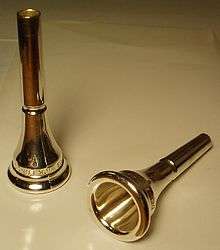
Mouthpiece
Mouthpiece may refer to:
- Mouthpiece (smoking pipe)
- Mouthpiece (telephone handset)
- Mouthpiece (woodwind), a component of a woodwind instrument
- Mouthpiece (brass), a component of a brass instrument
- Mouthpiece (scuba), a component of a scuba diving or industrial breathing set
- Mouthguard, a device protecting the teeth from injury, also known as mouth piece
Other

Mouthguard
A mouthguard (UK: gumshield) is a protective device for the mouth that covers the teeth and gums to prevent and reduce injury to the teeth, arches, lips and gums. A mouthguard is most often used to prevent injury in contact sports, as a treatment for bruxism or TMD, or as part of certain dental procedures, such as tooth bleaching. Depending on application, it may also be called a mouth protector, mouth piece, gumshield, gumguard, nightguard, occlusal splint, bite splint, or bite plane.
History
The exact origins of the mouthguard are unclear. Most evidence indicates that the concept of a mouthguard was initiated in the sport of boxing. Originally, boxers fashioned rudimentary mouthguards out of cotton, tape, sponge, or small pieces of wood. Boxers clenched the material between their teeth. These boxers had a hard time focusing on the fight and clenching their teeth at the same time. Since these devices proved impractical, Woolf Krause, a British dentist, began to fashion mouthpieces for boxers in 1892. Krause placed strips of a natural rubber resin, gutta-percha, over the maxillary incisors of boxers before they entered the ring. Phillip Krause, Woolf Krause’s son, is often credited with the first reusable mouthpiece. Phillip Krause’s invention was highlighted in a 1921 championship fight between Jack Britton and Ted "Kid" Lewis. Lewis was a school friend of Krauses’ and the first professional to utilize the new technology, then called a ‘gum shield.’ During the fight, Britton’s manager successfully argued that the mouthpiece was an illegal advantage. Philip Krause was an amateur boxer himself and undoubtedly used his own device before 1921.

Mouthpiece (scuba)
In breathing sets, a mouthpiece is a part that the user grips in his mouth, to make a watertight seal between the breathing set and his mouth. It is composed of a short flattened-oval tube that goes in between the lips, with on its free end a flange that fits between the lips and the tooth and gums. On the flange there are two projections with enlarged ends, which are gripped between the teeth. Most sport diving scuba sets use a mouthpiece rather than a fullface mask.
In many industrial breathing sets and a few scuba sets (e.g. the Siebe Gorman Salvus, and a 1980s model of double-hose diving regulator made by Nemrod), the mouthpiece also has an outer rubber flange that fits outside the lips and extends into two straps that fasten together behind the neck. That makes the mouthpiece more airtight and watertight, and helps to keep the mouthpiece in if the user lets his lips or jaws get slack through unconsciousness or absent-mindedness or being preoccupied with work.
A mouthpiece in the mouth prevents clear speech; as a result, many work divers, and many people who use a breathing set on land (e.g. firefighters), use a fullface mask.
Podcasts:

